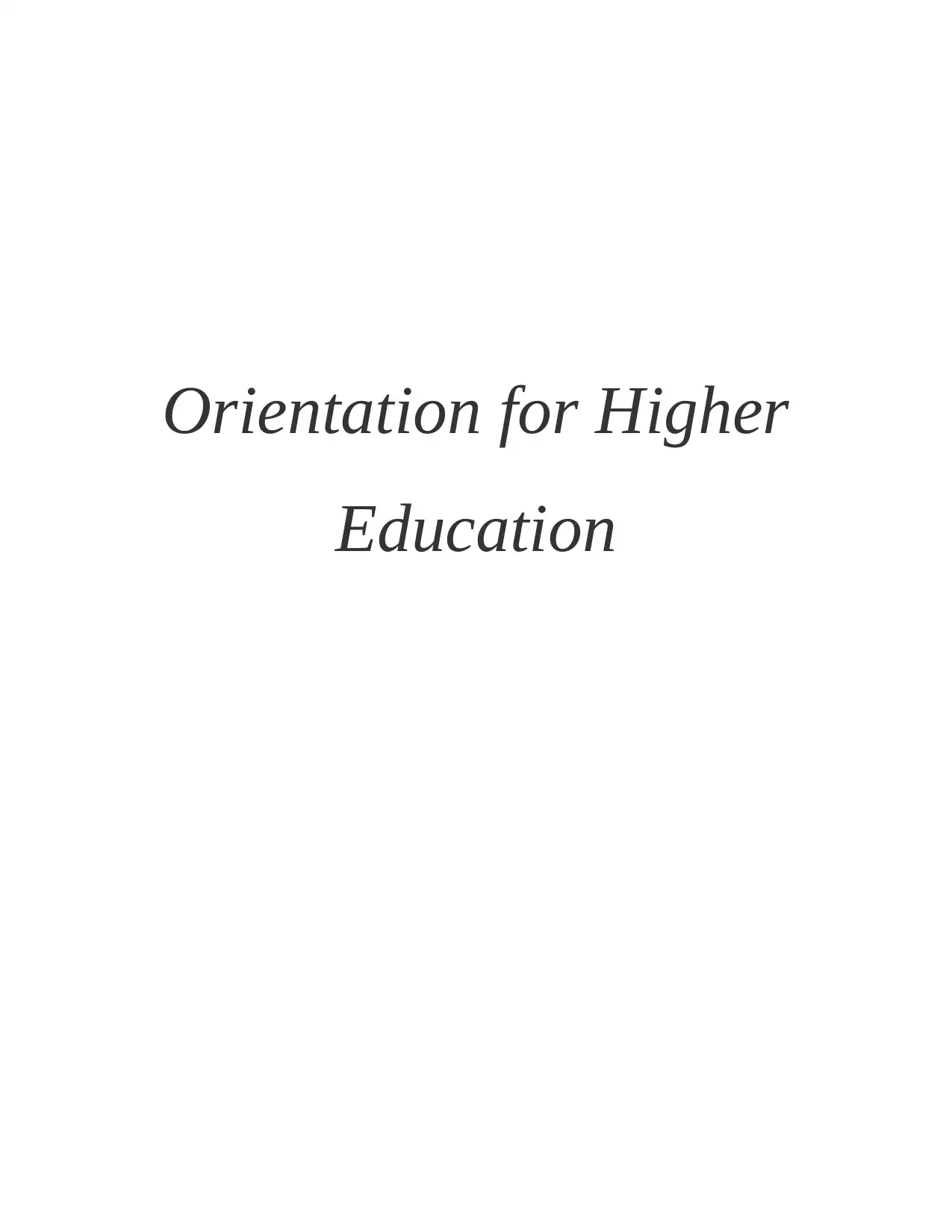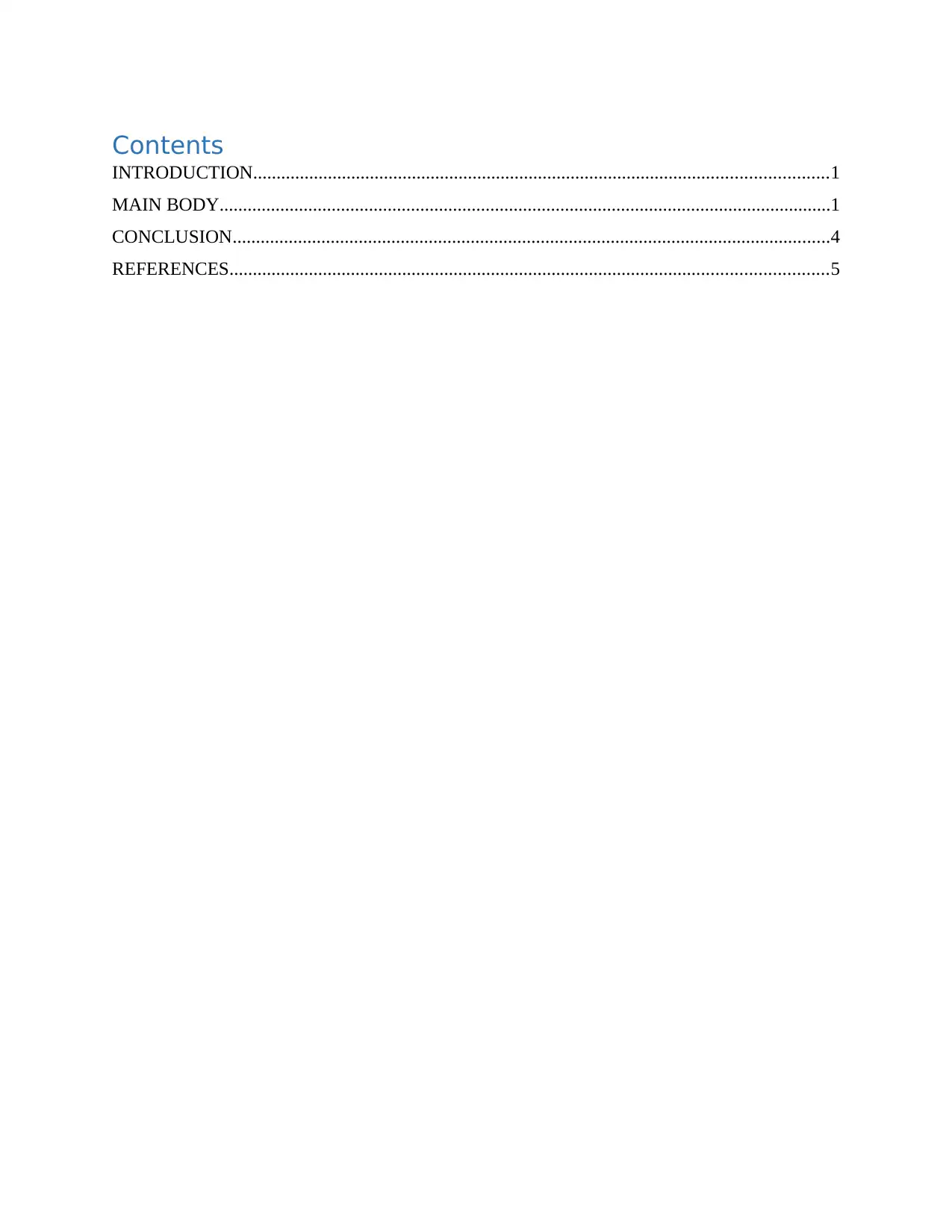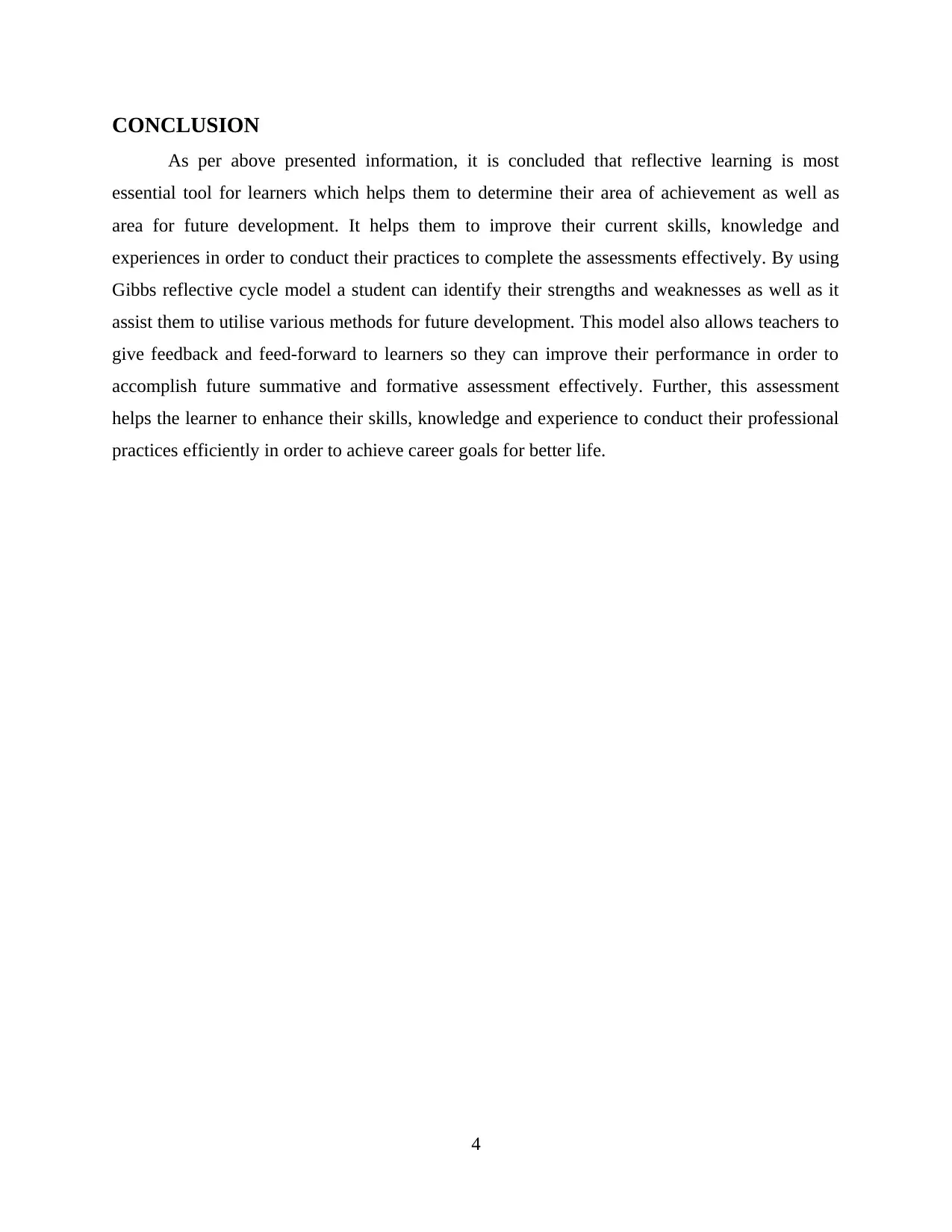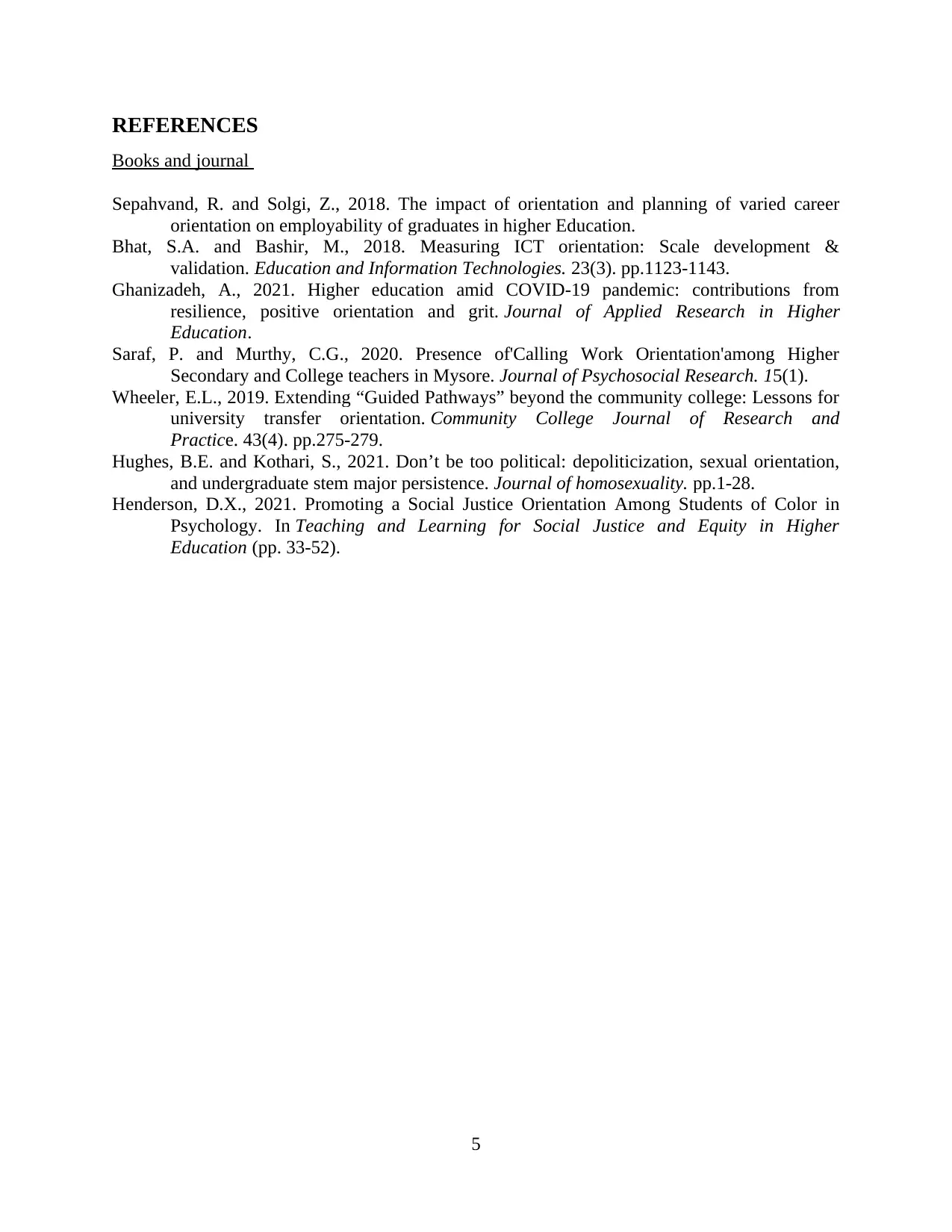Orientation for Higher Education: A Reflective Learning Approach
VerifiedAdded on 2023/06/11
|7
|1836
|334
Essay
AI Summary
This essay delves into the significance of reflective learning within higher education, employing Gibbs' reflective cycle as a framework. It emphasizes the importance of self-evaluation and learning from past experiences to enhance future performance. The essay further explores the roles of feedback and feed-forward in improving summative and formative assessments, highlighting how these mechanisms aid learners in identifying strengths and weaknesses. It underscores the teacher's responsibility in providing continuous feedback to motivate students and foster their development. The study concludes that reflective learning, facilitated by models like Gibbs' cycle, is crucial for students to improve their skills, knowledge, and experiences, ultimately contributing to their professional growth and career success. Desklib offers similar resources for students seeking academic support.

Orientation for Higher
Education
Education
Paraphrase This Document
Need a fresh take? Get an instant paraphrase of this document with our AI Paraphraser

Contents
INTRODUCTION...........................................................................................................................1
MAIN BODY...................................................................................................................................1
CONCLUSION................................................................................................................................4
REFERENCES................................................................................................................................5
INTRODUCTION...........................................................................................................................1
MAIN BODY...................................................................................................................................1
CONCLUSION................................................................................................................................4
REFERENCES................................................................................................................................5

INTRODUCTION
Reflecting learning refers to the active learning and understanding which helps a person
in managing the workload and their performance in an organisation as well as it also assists
student in managing their assignments during academic life. With the help of reflective learning
a student can identifies their strengths and weaknesses as well as evaluate their personal learning
behaviour. It is a form of learning which allows learners to examine their current skills and
knowledge as well as find the areas for development in order to achieve future success
(Sepahvand and Solgi, 2018). This also provide various types of learning or working methods to
learners but also provides them feedback and feed-forward in context to all problems that can be
faced by them in future projects. The following essay highlights the importance of reflective
learning with the use of Gibbs reflective life cycle. Further, it covers a reflective approach to
feedback and feed forward which can provide information to learners in order to improve their
future summative and formative assessment.
MAIN BODY
Reflective learning can be described as a type of education through which students reflect
and learn from their past experiences. Reflective learning typically encompasses looking back in
life for critically analysing any past experience or idea. Through evaluating successful as well as
unsuccessful aspects in relation to past experiences which help individuals in deep learning.
Gibb's reflective model is considered as significant for reflective learning as it also help in self-
evaluation of an individual in an effective manner. It is introduced by Graham Gibbs in 1998 to
provide effective reflective learning cycle. It provides a structure to learning from experiences
and education which can be measured by mistakes that will be corrected by learners in their
future practices (Bhat and Bashir, 2018). This model consists six steps in learning cycle which
helps a learner in reflecting their current skills, experiences as well as mistakes at university and
workplace. First stage is description, in this stage learner describe their experience what they
feel, learn and achieve while completing their project at University. Learner described their
situation with proper details like what they done and experience as well as result of that situation.
Next stage is feeling which they feel during the process of projects. Initially they feel nervous
but while conducting practices they generate understanding and confidence to compete project
with accuracy and efficiency. All thoughts and inner instincts has been given by them that are
1
Reflecting learning refers to the active learning and understanding which helps a person
in managing the workload and their performance in an organisation as well as it also assists
student in managing their assignments during academic life. With the help of reflective learning
a student can identifies their strengths and weaknesses as well as evaluate their personal learning
behaviour. It is a form of learning which allows learners to examine their current skills and
knowledge as well as find the areas for development in order to achieve future success
(Sepahvand and Solgi, 2018). This also provide various types of learning or working methods to
learners but also provides them feedback and feed-forward in context to all problems that can be
faced by them in future projects. The following essay highlights the importance of reflective
learning with the use of Gibbs reflective life cycle. Further, it covers a reflective approach to
feedback and feed forward which can provide information to learners in order to improve their
future summative and formative assessment.
MAIN BODY
Reflective learning can be described as a type of education through which students reflect
and learn from their past experiences. Reflective learning typically encompasses looking back in
life for critically analysing any past experience or idea. Through evaluating successful as well as
unsuccessful aspects in relation to past experiences which help individuals in deep learning.
Gibb's reflective model is considered as significant for reflective learning as it also help in self-
evaluation of an individual in an effective manner. It is introduced by Graham Gibbs in 1998 to
provide effective reflective learning cycle. It provides a structure to learning from experiences
and education which can be measured by mistakes that will be corrected by learners in their
future practices (Bhat and Bashir, 2018). This model consists six steps in learning cycle which
helps a learner in reflecting their current skills, experiences as well as mistakes at university and
workplace. First stage is description, in this stage learner describe their experience what they
feel, learn and achieve while completing their project at University. Learner described their
situation with proper details like what they done and experience as well as result of that situation.
Next stage is feeling which they feel during the process of projects. Initially they feel nervous
but while conducting practices they generate understanding and confidence to compete project
with accuracy and efficiency. All thoughts and inner instincts has been given by them that are
1
⊘ This is a preview!⊘
Do you want full access?
Subscribe today to unlock all pages.

Trusted by 1+ million students worldwide

running in minds of a learner while performing any project as well as going through same
situation. Third stage of this model is evaluation, in this stage all positive and negative features
of situation has been analysed and determined. Evaluation of practices is done by student that is
being done by them. It helps a learner in maintaining and managing their determination or focus
on area in that they facing as well as lacking major issues. Analysis is being considered as fourth
stage of this model in this learner have sense what they done as well as they also have chance to
make changes in order to reduce their mistakes (Ghanizadeh, 2021). With the helps of this stage
a learner can restructure their plan or processes and analysed all situations in context to find
mistakes, loopholes because of this projects do not conducted well. The next stage of this model
is conclusion, in that all results, knowledge and actions are detailed summarise that are acquired
by learner with help of project. In this stage they states what they learn during whole process of
project as well as what skills helps them to conduct practices and what skills they have to
improve to perform their task well in future. The last stage is action plan, in which a person make
a plan to conduct same practices with better knowledge and skills to complete it in better way as
compare to before (Wheeler, 2019). Further, they make proper plan of action to improve their
current knowledge and skills which they needed to perform well in future. Then they conduct
their practices and compare them with previous performance in order to find out what they can
do differently in future assignments.
Feedback is termed as review, response as well as final statement given by person on
some project, task or event done by a learner in order to make some improvement to achieve pre
determined standard. It provides positive and negative aspects of events to a learner in order to
provide information about their performance and work. Mostly feedback is given by experts and
superior whose have proper knowledge and experience in that field. Along with that, learner
received feedback from these people to make change in work as well as improve their skills and
knowledge to conduct better performance in future. With the helps of feedback, a learner get all
necessary information about their work as well as they also know area for improvement in order
to achieve goals effectively(Hughes and Kothari, 2021). Whereas, feed-forward is completely
opposite from feedback as feedback is given from evaluating past performances as well as feed-
forward is given by experts during the task to make changes in process of working to achieve the
goal in better manner. With the help of feed forward a learner stop their current work and
evaluate their performance to make changes in order manage practices in systematic manner to
2
situation. Third stage of this model is evaluation, in this stage all positive and negative features
of situation has been analysed and determined. Evaluation of practices is done by student that is
being done by them. It helps a learner in maintaining and managing their determination or focus
on area in that they facing as well as lacking major issues. Analysis is being considered as fourth
stage of this model in this learner have sense what they done as well as they also have chance to
make changes in order to reduce their mistakes (Ghanizadeh, 2021). With the helps of this stage
a learner can restructure their plan or processes and analysed all situations in context to find
mistakes, loopholes because of this projects do not conducted well. The next stage of this model
is conclusion, in that all results, knowledge and actions are detailed summarise that are acquired
by learner with help of project. In this stage they states what they learn during whole process of
project as well as what skills helps them to conduct practices and what skills they have to
improve to perform their task well in future. The last stage is action plan, in which a person make
a plan to conduct same practices with better knowledge and skills to complete it in better way as
compare to before (Wheeler, 2019). Further, they make proper plan of action to improve their
current knowledge and skills which they needed to perform well in future. Then they conduct
their practices and compare them with previous performance in order to find out what they can
do differently in future assignments.
Feedback is termed as review, response as well as final statement given by person on
some project, task or event done by a learner in order to make some improvement to achieve pre
determined standard. It provides positive and negative aspects of events to a learner in order to
provide information about their performance and work. Mostly feedback is given by experts and
superior whose have proper knowledge and experience in that field. Along with that, learner
received feedback from these people to make change in work as well as improve their skills and
knowledge to conduct better performance in future. With the helps of feedback, a learner get all
necessary information about their work as well as they also know area for improvement in order
to achieve goals effectively(Hughes and Kothari, 2021). Whereas, feed-forward is completely
opposite from feedback as feedback is given from evaluating past performances as well as feed-
forward is given by experts during the task to make changes in process of working to achieve the
goal in better manner. With the help of feed forward a learner stop their current work and
evaluate their performance to make changes in order manage practices in systematic manner to
2
Paraphrase This Document
Need a fresh take? Get an instant paraphrase of this document with our AI Paraphraser

accomplish future goals effectively. This is suggestions and ideas provided by mentor to learner
in order to overcome from obstacles which is faced by them while performing task, so they can
improve their current practices to complete project effectively without any mistake or problem.
Process of feedbacks as well as feed forwards is properly determine by learner with the help of
Gibb's reflective cycle which is most essential tool for them to achieve future success. All the
stages of Gibb's reflective model are the part of feedback as well as all learners must use to
determine the negative and positive aspects related to situation or task. Feed-forward is also
considered as a part of this model which is used by learner at the last stage. By using Action plan
step of Gibb's cycle a learner can easily determine the future objectives as well as make
effective plan in order to improve performance to conduct practices in a effective manner. Feed-
forward helps a person in reflecting their experience as well as preparing them for future task.
So they can manage their work in most systematic manner as well as implement all stage of this
model in effective way to get better knowledge for working (Saraf and Murthy, 2020).
Moreover, a student can also use reflective cycle model in their normal working in order to get
multiple feedbacks to know more methods and idea for better working. Along with that, the feed-
forward also helps an individual in managing the future task to achieve the success so it is
considered as essential part of learning.
Feedback and feed forward plays most important part in learner education as it helps
them in managing their learning process and work well along with that it also assist them to
overcome from various issues or obstacles which they are facing constantly. Moreover, it
provide various methods to them which they can use to handle their future problems effectively.
Along with that, it allows them to evaluate their performance as well as to find out positive and
negative aspects so they conduct their practices in order to complete summative and formative
assessment effectively (Henderson, 2021). These two terms provide a base and future plan to
them so they can improve their current skills and knowledge to work as plan as well as achieve
the goal efficiently. It is the responsibility of teacher to continuously evaluate the performance of
their students to provide feedback and feed-forward to them which leads to increase their
performance and skills. Also, these helps a learner to feel motivated and confident to improve
their effectiveness in order to complete their assessment for future development.
3
in order to overcome from obstacles which is faced by them while performing task, so they can
improve their current practices to complete project effectively without any mistake or problem.
Process of feedbacks as well as feed forwards is properly determine by learner with the help of
Gibb's reflective cycle which is most essential tool for them to achieve future success. All the
stages of Gibb's reflective model are the part of feedback as well as all learners must use to
determine the negative and positive aspects related to situation or task. Feed-forward is also
considered as a part of this model which is used by learner at the last stage. By using Action plan
step of Gibb's cycle a learner can easily determine the future objectives as well as make
effective plan in order to improve performance to conduct practices in a effective manner. Feed-
forward helps a person in reflecting their experience as well as preparing them for future task.
So they can manage their work in most systematic manner as well as implement all stage of this
model in effective way to get better knowledge for working (Saraf and Murthy, 2020).
Moreover, a student can also use reflective cycle model in their normal working in order to get
multiple feedbacks to know more methods and idea for better working. Along with that, the feed-
forward also helps an individual in managing the future task to achieve the success so it is
considered as essential part of learning.
Feedback and feed forward plays most important part in learner education as it helps
them in managing their learning process and work well along with that it also assist them to
overcome from various issues or obstacles which they are facing constantly. Moreover, it
provide various methods to them which they can use to handle their future problems effectively.
Along with that, it allows them to evaluate their performance as well as to find out positive and
negative aspects so they conduct their practices in order to complete summative and formative
assessment effectively (Henderson, 2021). These two terms provide a base and future plan to
them so they can improve their current skills and knowledge to work as plan as well as achieve
the goal efficiently. It is the responsibility of teacher to continuously evaluate the performance of
their students to provide feedback and feed-forward to them which leads to increase their
performance and skills. Also, these helps a learner to feel motivated and confident to improve
their effectiveness in order to complete their assessment for future development.
3

CONCLUSION
As per above presented information, it is concluded that reflective learning is most
essential tool for learners which helps them to determine their area of achievement as well as
area for future development. It helps them to improve their current skills, knowledge and
experiences in order to conduct their practices to complete the assessments effectively. By using
Gibbs reflective cycle model a student can identify their strengths and weaknesses as well as it
assist them to utilise various methods for future development. This model also allows teachers to
give feedback and feed-forward to learners so they can improve their performance in order to
accomplish future summative and formative assessment effectively. Further, this assessment
helps the learner to enhance their skills, knowledge and experience to conduct their professional
practices efficiently in order to achieve career goals for better life.
4
As per above presented information, it is concluded that reflective learning is most
essential tool for learners which helps them to determine their area of achievement as well as
area for future development. It helps them to improve their current skills, knowledge and
experiences in order to conduct their practices to complete the assessments effectively. By using
Gibbs reflective cycle model a student can identify their strengths and weaknesses as well as it
assist them to utilise various methods for future development. This model also allows teachers to
give feedback and feed-forward to learners so they can improve their performance in order to
accomplish future summative and formative assessment effectively. Further, this assessment
helps the learner to enhance their skills, knowledge and experience to conduct their professional
practices efficiently in order to achieve career goals for better life.
4
⊘ This is a preview!⊘
Do you want full access?
Subscribe today to unlock all pages.

Trusted by 1+ million students worldwide

REFERENCES
Books and journal
Sepahvand, R. and Solgi, Z., 2018. The impact of orientation and planning of varied career
orientation on employability of graduates in higher Education.
Bhat, S.A. and Bashir, M., 2018. Measuring ICT orientation: Scale development &
validation. Education and Information Technologies. 23(3). pp.1123-1143.
Ghanizadeh, A., 2021. Higher education amid COVID-19 pandemic: contributions from
resilience, positive orientation and grit. Journal of Applied Research in Higher
Education.
Saraf, P. and Murthy, C.G., 2020. Presence of'Calling Work Orientation'among Higher
Secondary and College teachers in Mysore. Journal of Psychosocial Research. 15(1).
Wheeler, E.L., 2019. Extending “Guided Pathways” beyond the community college: Lessons for
university transfer orientation. Community College Journal of Research and
Practice. 43(4). pp.275-279.
Hughes, B.E. and Kothari, S., 2021. Don’t be too political: depoliticization, sexual orientation,
and undergraduate stem major persistence. Journal of homosexuality. pp.1-28.
Henderson, D.X., 2021. Promoting a Social Justice Orientation Among Students of Color in
Psychology. In Teaching and Learning for Social Justice and Equity in Higher
Education (pp. 33-52).
5
Books and journal
Sepahvand, R. and Solgi, Z., 2018. The impact of orientation and planning of varied career
orientation on employability of graduates in higher Education.
Bhat, S.A. and Bashir, M., 2018. Measuring ICT orientation: Scale development &
validation. Education and Information Technologies. 23(3). pp.1123-1143.
Ghanizadeh, A., 2021. Higher education amid COVID-19 pandemic: contributions from
resilience, positive orientation and grit. Journal of Applied Research in Higher
Education.
Saraf, P. and Murthy, C.G., 2020. Presence of'Calling Work Orientation'among Higher
Secondary and College teachers in Mysore. Journal of Psychosocial Research. 15(1).
Wheeler, E.L., 2019. Extending “Guided Pathways” beyond the community college: Lessons for
university transfer orientation. Community College Journal of Research and
Practice. 43(4). pp.275-279.
Hughes, B.E. and Kothari, S., 2021. Don’t be too political: depoliticization, sexual orientation,
and undergraduate stem major persistence. Journal of homosexuality. pp.1-28.
Henderson, D.X., 2021. Promoting a Social Justice Orientation Among Students of Color in
Psychology. In Teaching and Learning for Social Justice and Equity in Higher
Education (pp. 33-52).
5
1 out of 7
Related Documents
Your All-in-One AI-Powered Toolkit for Academic Success.
+13062052269
info@desklib.com
Available 24*7 on WhatsApp / Email
![[object Object]](/_next/static/media/star-bottom.7253800d.svg)
Unlock your academic potential
Copyright © 2020–2025 A2Z Services. All Rights Reserved. Developed and managed by ZUCOL.


